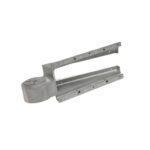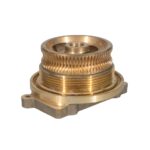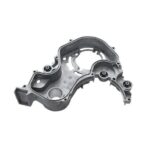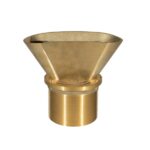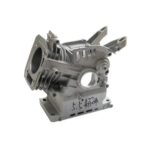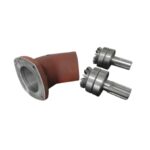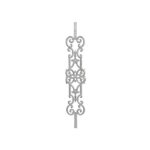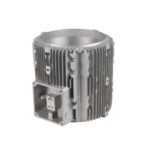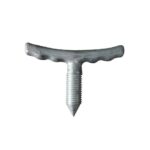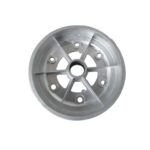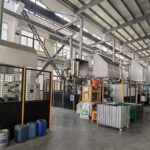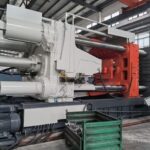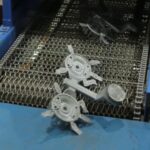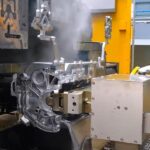A356 aluminum (Al-Si-Mg) is a heat-treatable casting alloy prized for a strong balance of castability, corrosion resistance, and mechanical performance—especially after T6. It’s widely used for chassis and structural automotive parts, pumps and valves, compressor housings, and marine hardware. Below is a practical, engineering-grade guide to A356 composition, properties, heat treatment, casting routes (and when to choose die casting vs alternatives), design rules, typical defects and fixes, surface finishing, tolerances, costs, and an RFQ checklist.
A356 Aluminum Composition and Designation
- Nominal chemistry (wt%): Si 6.5–7.5, Mg 0.25–0.45, Fe ≤0.2, Cu ≤0.2, Mn ≤0.1, Zn ≤0.1, Ti ≤0.2, balance Al.
- Standards & aliases: ASTM A356 (cast), UNS A13560, EN AC-AlSi7Mg0.3 (similar), JIS AC4C (close family).
- Why Mg matters: Enables precipitation hardening (T6), boosting strength and elongation.
- Why low Fe matters: Reduces β-Al5FeSi platelets that embrittle castings and harm ductility.
A356 Aluminum Mechanical Properties (As-Cast, T5, T6)
Typical values (gravity permanent mold/LPDC quality; actual results depend on melt quality, hydrogen control, modifiers, and section thickness).
| Temper | UTS (MPa) | YS (MPa) | Elongation (%) | Brinell HB | Notes |
|---|---|---|---|---|---|
| As-cast (F) | 160–210 | 90–140 | 2–6 | 60–80 | Best castability, lowest cost |
| T5 (paint-bake) | 200–240 | 140–170 | 2–5 | 70–85 | From artificial aging only |
| T6 | 250–310 | 170–230 | 4–10 | 80–100 | Solution + quench + age; requires clean, dense castings |
Reality check: Thin sections, gas, and oxides depress elongation first. Property scatter usually signals pore/oxide issues, not “bad alloy.”
A356 Aluminum T6 Heat Treatment Step by Step
- Solution treat: 540–550 °C (1000–1020 °F), 6–10 h (section-dependent) for Mg2Si dissolution.
- Quench: Water 60–80 °C to limit distortion/blister risk (use fixtures for critical geometry).
- Artificial age: 155–170 °C (310–338 °F), 4–8 h to reach target strength/elongation balance.
- Verification: Test casting-integral tensile bars; X-ray or CT per spec to confirm density class.
Shop tips that actually move the needle
- Degas to ≤0.15 mL/100 g H₂ (reduced pressure test).
- Strontium modification (≈120–200 ppm) refines eutectic Si → better elongation.
- Use solid feeders/sleeves; LPDC/GPM gating that avoids surface turbulence.
- Avoid over-aging—watch hardness trend; target HB 85–95 for typical T6 builds.
A356 Aluminum Casting Methods and When to Use Them
- Sand casting: Best for prototypes/large cross-sections. Most tolerant to geometry changes; coarser microstructure; T6 feasible with good melt practice.
- Gravity permanent mold (GPM): Higher density and repeatability than sand; excellent for medium volumes and improved fatigue.
- Low-pressure die casting (LPDC): Clean feed from crucible through a stalk; excellent density and control; ideal for A356-T6 structural parts.
- High-pressure die casting (HPDC): Best for thin-wall speed and mass production—but not ideal for A356-T6 due to gas/oxide entrapment (details next).
A356 Aluminum in Die Casting — What’s Realistic and What We Recommend
A356 shines when you need heat-treatable T6 strength and elongation. HPDC, however, is typically not the best route for A356-T6:
- Process–metallurgy conflict: Mg raises oxidation/hydrogen sensitivity. HPDC’s fast filling traps gas/oxides that T6 can exacerbate (blistering/low El%).
- Typical HPDC practice: Most Al-Si HPDC parts run as-cast or paint-bake (T5-like), not full T6—especially on A356.
- Better HPDC alloys: A380/ADC12/A360—superior thin-wall fill, stable as-cast properties, great economics.
When A356 is required for T6 performance, choose LPDC or GPM. They deliver cleaner metal and feeding control, enabling reliable T6 properties.
Quick selection table
| Scenario | Best-fit alloy & route | Why |
|---|---|---|
| Very thin walls, complex ribs, huge volumes | A380/ADC12 via HPDC | Extreme castability, cost-effective cycles, paint-bake ready |
| Structural casting with T6 | A356 via LPDC/GPM | Clean melt + solid feeding → low porosity → consistent T6 |
| Corrosion-sensitive, moderate walls | A356-T6 (LPDC/GPM) or A360 (HPDC) | T6 strength/ductility or good HPDC castability & corrosion |
Pro tip: If your print says “A356-T6 HPDC,” talk to us. We often save programs by either (1) keeping A356 and switching to LPDC/GPM, or (2) keeping HPDC but changing to A380/ADC12/A360 with a property path (paint-bake, inserts, geometry tweaks).
What Yongzhu Casting will do
- Processes we run: HPDC (A380/ADC12/A360), LPDC/GPM (A356-T6), sand for prototypes.
- Upfront DFM: Fill/solidification simulation, hydrogen control plan, X-ray class, heat-treat window definition.
- Validation: CT/X-ray per spec, tensile from casting-integral bars, leak testing, cosmetic & coating trials.
RFQ checklist (paste into your email to yongzhucasting@gmail.com):
annual volume • net weight • min/typical wall • target UTS/YS/El • temper (F/T5/T6) • X-ray/CT class • leak-rate • process preference (HPDC/LPDC/GPM) • surface finish • drawings (STEP/PDF) • critical GD&T or sealing lines
A356 Aluminum Design Guidelines for Casting
Gating & feeding
- Favor bottom-fill and gentle runners; avoid waterfall jets and 90° turns.
- Use risers/sleeves on thick sections; place chills to pull hot spots.
- Bosses/ribs: fillet ≥ 0.25–0.5× wall; rib thickness 0.5–0.7× wall.
Wall & transitions
- Uniform walls (±20%) to curb distortion/porosity.
- Avoid isolated heavy pads; split mass with ribs or hollow cores.
- Draft: 0.5–1.0° polished, 1–2° shot-blast.
Threads & inserts
- Use steel inserts for highly loaded threads; consider Heli-Coils.
- Put inserts on the parting side when possible; relieve stress with fillets.
A356 Aluminum Defects to Watch and Practical Fixes
| Defect | Root cause | Prevention / remedy |
|---|---|---|
| Gas porosity | H₂ high, turbulence, poor venting | Degas to ≤0.15 mL/100 g; bottom-fill; use filters; vent risers |
| Shrink porosity | Feeding short; hot spots | Add risers/sleeves; chills; modulus-based feeder design |
| Oxide films | Splashing, re-melt skin | Skim & filter; calm gating; avoid waterfall runners |
| Hot tears | Constrained contraction | Redesign junctions; fillet; uniform wall; controlled quench |
| Blistering in T6 | Trapped gas/contaminants | Improve density before HT; gentler quench; fixture; validate with coupons |
A356 vs 356 vs A380 vs 6061 — How to Choose
| Property / Need | A356 (LPDC/GPM, T6) | 356 (T6) | A380 (HPDC) | 6061 wrought |
|---|---|---|---|---|
| Castability (thin wall) | ●●○ | ●●○ | ●●● | n/a (wrought) |
| Strength (typical) | High (T6) | High (T6) | Medium (as-cast/T5) | Very high (T6) |
| Elongation potential | Good (4–10%) | Good (3–8%) | Low–medium | Very good |
| Corrosion resistance | Good | Good | Good | Very good |
| Best processes | LPDC/GPM, sand | LPDC/GPM, sand | HPDC | Extrusion/forging/machining |
Surface Finishing for A356 Aluminum Castings
- As-cast, shot-blast, tumble for cost-down cosmetic.
- Machined cosmetic for sealing faces and functional interfaces.
- Anodizing: Clear or dyed; for best cosmetic, specify LPDC/GPM, tight Ra after polishing, alkaline etch control, and mask threaded/grounded areas.
- Powder coating / wet paint: Excellent for outdoor parts; define salt-spray and impact targets.
- Conversion coatings: Alodine for bonding/paint prep; define class.
Tolerances You Can Actually Hold
- General casting tolerance: CT7–CT8 typical for LPDC/GPM; sand CT9–CT10 (ISO 8062-3).
- Machined features: ±0.05–0.10 mm common on bores/faces with proper fixturing.
- Flatness/parallelism: Design with pads and balance cuts; call out only what function needs.
- Positional tolerances: Include datum strategy that respects parting and clamp.
Cost Drivers for A356 Aluminum Casting
- Process choice: LPDC/GPM cycle time vs sand tooling/finishing; HPDC cheaper per shot but not A356-T6 friendly.
- Yield & density targets: Feeder metal, filters, X-ray class, CT all move cost.
- Heat treatment: Full T6 adds energy + rack time + handling + inspection.
- Secondary ops: Machining, leak-test, finishing, assembly.
- Volume/EOQ: Batch sizes and release cadence set real unit economics.
Typical A356 Aluminum Applications
- Suspension/knuckle/arm housings, shock mounts, cross-member nodes
- Pump, compressor, and blower housings
- Marine hardware, steering components
- Structural brackets needing T6 elongation
Request a Quote — And Let’s Pick the Right Route Together
- If you need T6 structural performance: A356 via LPDC/GPM is usually your best bet.
- If you need thin walls and huge volume: HPDC with A380/ADC12/A360 is likely better.
Send your RFQ (STEP + PDF) to sales@casting-yz.com. We’ll return a route & alloy recommendation and a detailed quote.
Frequently Asked Questions about A356 Aluminum
These address questions engineers often ask that go beyond the basics in the main text.
Q1. Is A356 aluminum good for casting?
A. Yes—particularly for LPDC/GPM when you want a heat-treatable, corrosion-resistant alloy with solid T6 performance. It’s less tolerant of HPDC’s turbulence than A380/ADC12 but outperforms them when you need elongation and higher fracture toughness after T6.
Q2. What is the difference between A356 and 356?
A. Very similar families (Al-Si-Mg). A356 controls Fe a bit lower and Mg a bit tighter, which improves ductility and makes T6 results more repeatable. In practice, many buyers use them interchangeably but specify A356 for critical elongation.
Q3. Can I heat-treat A356 after high-pressure die casting?
A. It’s possible but risky. Internal gas/oxide defects can blister in solution treatment and create large scatter in El%. Most HPDC programs avoid full T6 on A356; if T6 is mandatory, move to LPDC/GPM.
Q4. Is A356 stronger than 6061?
A. Wrought 6061-T6 is generally stronger and tougher than cast A356-T6. If your geometry can be cast and you need integral features, A356-T6 is a good casting choice; if you can machine from plate/extrusion, 6061-T6 may deliver higher properties.
Q5. Can A356 be welded?
A. Yes, with compatible fillers (e.g., 4043/5356). Pre-clean, keep heat input controlled, and expect T6 properties to locally drop in the HAZ unless you re-age per process spec.
Q6. What density and melting range should I assume in calculations?
A. Density ≈ 2.66–2.68 g/cm³; liquidus ~615 °C and solidus ~555 °C. Use section-specific knock-downs for casting porosity in critical stress models unless you qualify density by CT/X-ray.
Q7. What is the best aluminum grade for high-volume die casting?
A. Usually A380/ADC12/A360—they fill thin walls and tolerate HPDC cycles better. Choose A356 when you can use LPDC/GPM and need T6 elongation/strength.


